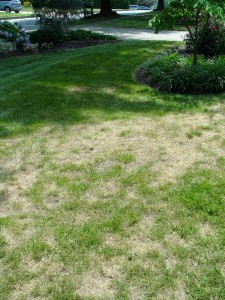Lawn Brownouts
July 18th, 2010
Interesting thing about how lawns have bounced back (or not) from last week’s rain that followed the three-week blow-torch dry spell.
Some sections have greened up just fine. Others look like the grass went from brown and dormant to brown and dead. Why the discrepancy?
These five reasons explain most of it:
1.) Lousy soil. If you’ve got lousy clay or compacted subsoil under the grass, the roots are poorly developed and much more prone to dying off faster than a lawn with deep roots in good soil.
2.) Hot spots. Most of the dead spots I’m seeing are out in the open where the grass got hammered all day long by full sun and relentless near-100-degree heat. Lawns shaded by trees or protected from afternoon sun by buildings are generally the patches that are green again.
3.) Scalping. Here’s the biggie. People who cut the grass short – especially those who cut short heading into or during the heat wave – paid the price. Longer grass blades shade the soil better, slowing evaporation and keeping soil temperatures cooler. Those longer blades also don’t dry out as fast as short blades, and they encourage deeper rooting. When it started getting hot and dry, I purposely didn’t cut the grass, and almost all of it came back fine. Much of it never browned out in the first place. Move your mower setting up to cut at 3 inches and don’t cut when the lawn is going dormant.
4.) Chinch bugs. It’s possible these blade-sucking little bugs are really to blame for some of the dead spots. They’re active in summer and could’ve done their damage coincidentally during the heat spell. Look closely for them or cut the bottom off a coffee can, jam it into a spot near the damage and flood the can. Then look for chinch bugs floating. Lawn insecticides kill them.
5.) Salt. Dead spots that run along sidewalks, roads and driveways most likely are the result of ice-melting salt buildup from winter. Excess sodium worsens drought effects. The solution (short of a lot of rain to leach it out) is knocking off the use of rock salt or adding gypsum to the soil.
We’re not done with the heat yet, it seems. Keep those plants watered – especially trees and shrubs planted in the last two years. You don’t want to lose the expensive stuff that hasn’t fully rooted yet. Trees may take 4 or 5 years to really establish themselves. Remember, water woody plants deeply once a week in hot, dry weather – not lightly every night or two.
Trip News
W. Atlee Burpee Co. has canceled its Harvest Festival this year, but Lowee’s Group Tours and I have retrofitted our planned Aug. 20 bus trip by subbing the morning stop with a tour of Temple University’s Ambler Arboretum.
We’ll spend the morning touring Ambler’s display gardens and landscape grounds, then have lunch, then spend the afternoon at Del Valley College’s Schmieder Arboretum before spending an hour or so at Michael Petrie’s new garden center near Downingtown. Michael is the genius who does most of the wildest, award-winning displays at the Philly Flower Show. We’ll finish the day with dinner (included) at Firecreek Restaurant. Cost is $99. Sign up by calling Lowee’s at 657-9658 or emailing CKelly@lowees.com.
Lowee’s also has put the finishing touches on our Oct. 15 behind-the-scenes trip to Longwood Gardens. This one isn’t your usual tour of Longwood. We’re going to visit Longwood’s Production Greenhouse to see how the staff grows and prepares plants for display, plus visit their plant trials, see how they store bulbs, how they control pests and more. We’ll then have a private cooking demo with Longwood’s executive chef, eat a gourmet lunch and spend time learning more secrets from several of Longwood’s senior gardeners in the afternoon. A couple of hours of free time to explore are built in. Cost is $149. Same contact info as above to sign up. Or hit the “George’s Talks and Trips” button above to get details on all of the remaining 2010 trips.








